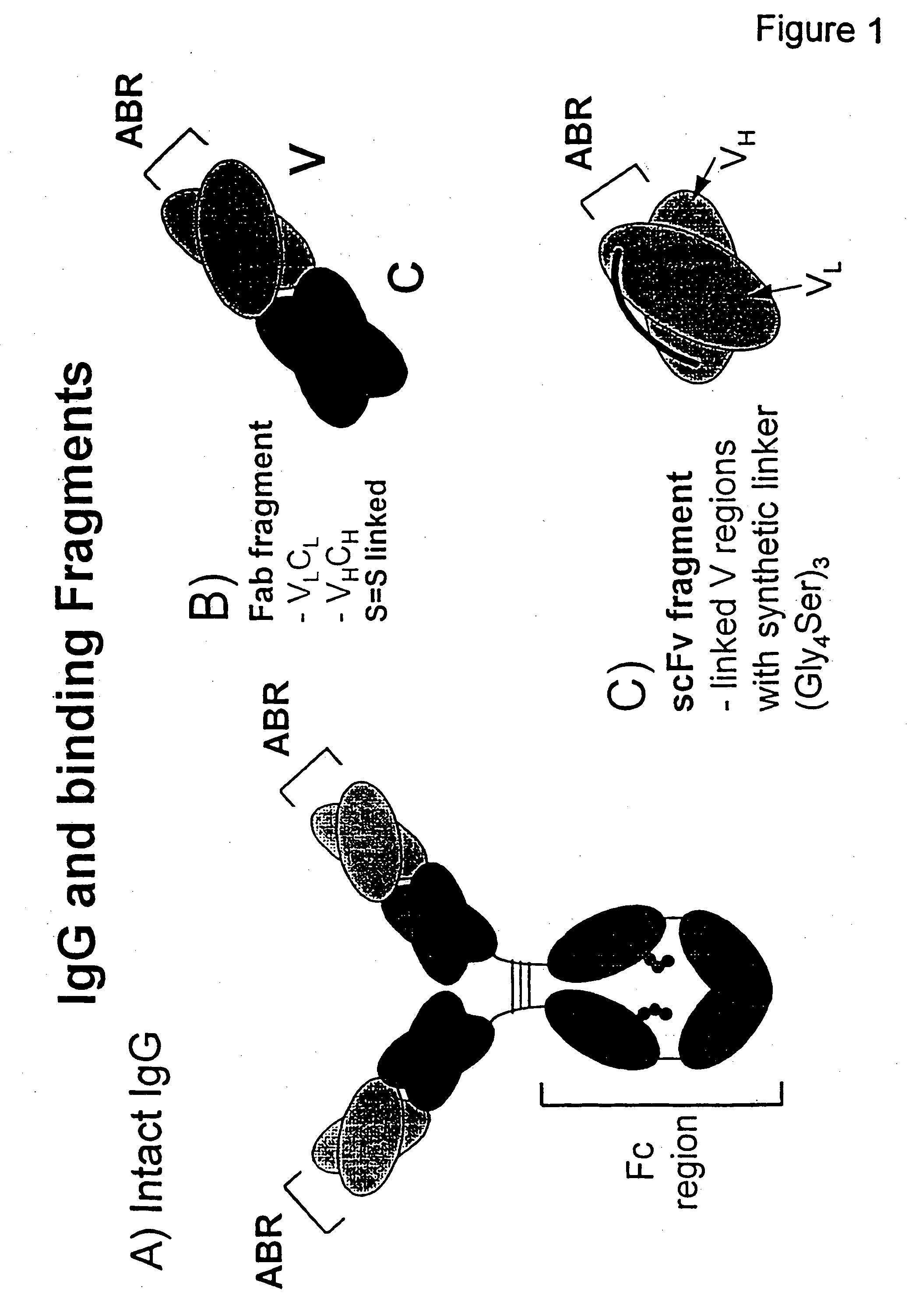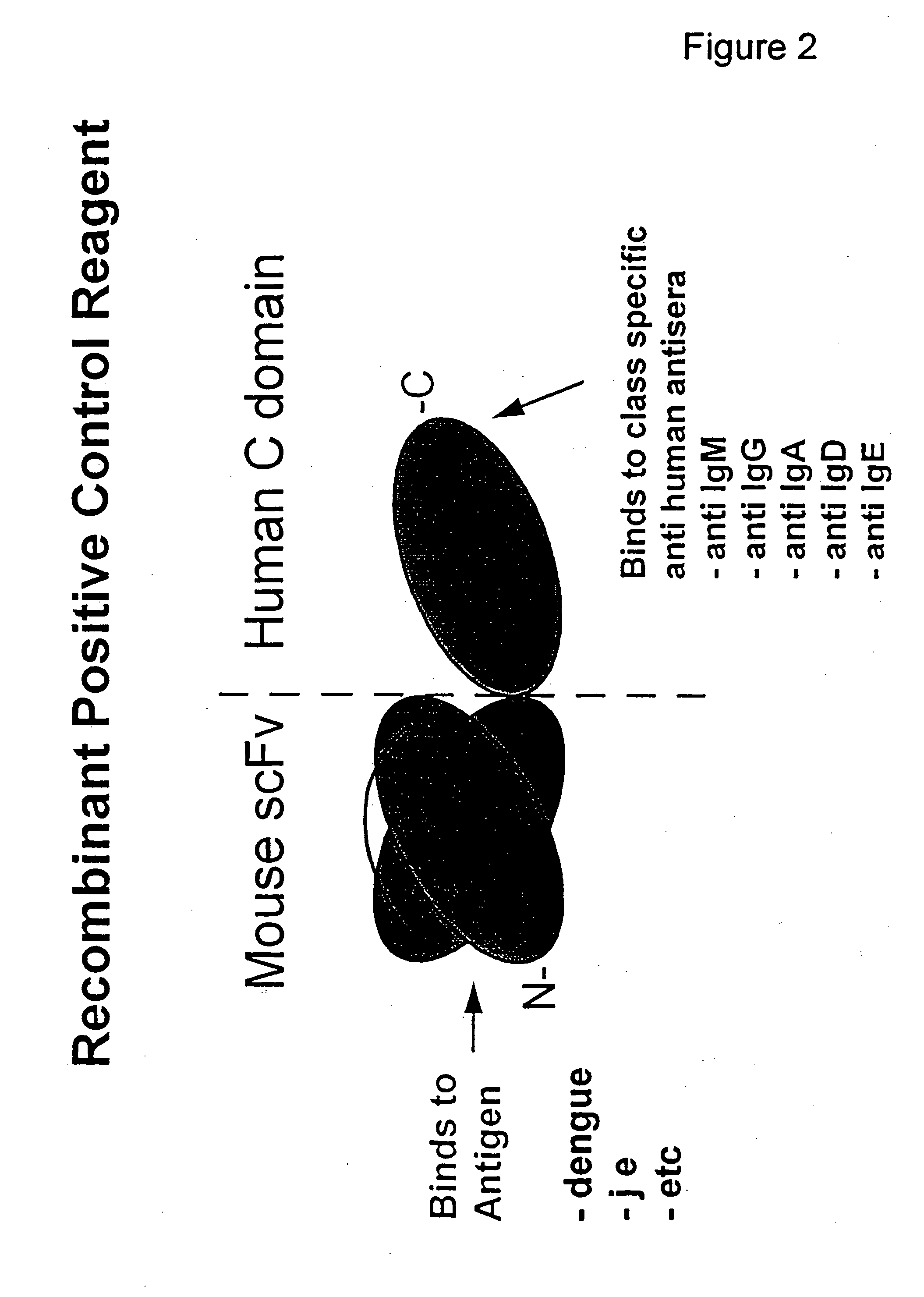Bifunctional molecules
- Summary
- Abstract
- Description
- Claims
- Application Information
AI Technical Summary
Benefits of technology
Problems solved by technology
Method used
Image
Examples
example 1
Production of a C-Domain (IgM) Extended scFv
[0100] The gene sequences of the four constant domains (C domains) of human IgM heavy chain were separately amplified from cDNA prepared from mRNA isolated from human peripheral blood lymphocytes using polymerase chain reaction techniques. The design of the oligonucleotide primers used in the amplifications was based upon the 5′ and 3′ base sequence of each of the four IgM heavy chain exons, obtained through GENBANK accession X14940 (Dorai and Gillies, 1989).
[0101] In the primers, specific restriction enzyme recognition sequences were added (NotI at the 5′ end and SacII at the 3′ end) to each exon sequence to facilitate the introduction of the C domain sequence at a specific site in a previously constructed plasmid expression vector. The expression cassette of this E. coli plasmid vector (pGC; Coia et al., 1996) contained VH and VL sequences from the mouse monoclonal antibody cell line 1C3, (Rylatt et al., 1990, WO91 / 04492) with binding...
example 2
Construction of Extended scFv (13C11 Antidengue) Linked to a Human IgM C Domain
[0105] The reagent was produced from a DNA construct in which the coding region for a mouse scFv directed against dengue virus was genetically linked to that of the third constant domain of human IgM heavy chain (CH3μ), cDNA was prepared from mRNA isolated from the mouse monoclonal antibody cell line 13C11, which specificity for Dengue virus surface antigens (Queensland University of Technology and PanBio Pty Ltd.). Immunoglobulin VH and VL domain DNA sequences were amplified from the cDNA using polymerase chain reaction and oligonucleotide primer sets according to Zhou et al. (1994). These were linked in the scFv format VH-linker-VL, where the linker was a 45 bp nucleic acid sequence coding for the protein sequence GGGGSGGGGSGGGGSGGGGS. The resultant fragment was digested with restriction endonucleases Nco I and Not I and purified by agarose gel electrophoresis. The expression vector as described in Exa...
example 3
Construction of Extended scFv (13C11 Anti Dengue) Linked to a Human IgG C-Domain
[0109] The gene sequences of human IgG constant domains 2 and 3 were separately amplified from cDNA from mRNA isolated from human peripheral blood lymphocytes using polymerase chain reaction techniques. The design of the oligonucleotide primers used in the amplifications were based upon the 5′ and 3′ sequences for each of the heavy chain exons obtained through Genbank accession no E06998.
[0110] Sequences coding for NotI and SacII restriction sites were added to the 5′ and 3′ end respectively of the CH2γ and CH3γ sequences to enable the insertion into pGC 13C11-CH3μ from which the CH3μ sequence had been removed as a NotI-SacIh fragment.
[0111] Expression in E. coli and purification of product was performed as described in Example 2. The presence of product in the periplasmic fraction was confirmed by analysis of samples by polyacrylamide gel electrophoresis and Western blotting, probing the FLAG® tag us...
PUM
| Property | Measurement | Unit |
|---|---|---|
| Molar density | aaaaa | aaaaa |
| Molar density | aaaaa | aaaaa |
| Fraction | aaaaa | aaaaa |
Abstract
Description
Claims
Application Information
 Login to View More
Login to View More - R&D
- Intellectual Property
- Life Sciences
- Materials
- Tech Scout
- Unparalleled Data Quality
- Higher Quality Content
- 60% Fewer Hallucinations
Browse by: Latest US Patents, China's latest patents, Technical Efficacy Thesaurus, Application Domain, Technology Topic, Popular Technical Reports.
© 2025 PatSnap. All rights reserved.Legal|Privacy policy|Modern Slavery Act Transparency Statement|Sitemap|About US| Contact US: help@patsnap.com



